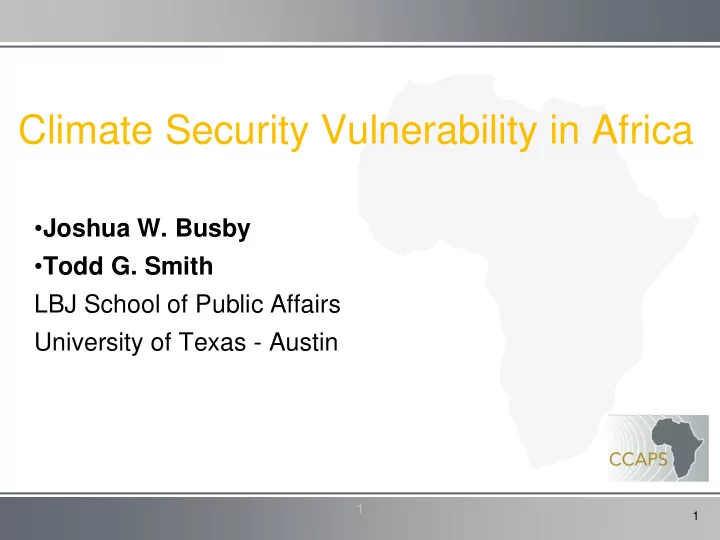

Climate Security Vulnerability in Africa • Joshua W. Busby • Todd G. Smith LBJ School of Public Affairs University of Texas - Austin 1 1
Agenda • Brief introduction of project • Discussion of our vulnerability mapping methodology and continent-wide maps • Application to East Africa • Extensions • New Indicators 2 2
Climate Change and African Political Stability (CCAPS) • North Texas - Idean Salehyan • William and Mary - Cullen Hendrix - Mike Tierney • Trinity College - Clionadh Raleigh • Brown University - Timmons Roberts This material is based upon work supported by, or in part by, the U. S. Army Research Laboratory and the U. S. Army Research Office under contract/grant number W911NF-09-1- 0077. 3 3
CCAPS http:// ccaps.aiddata.org / http://www.strausscenter.org/ccaps 4 4
Question • How can we talk about the security consequences of climate change in Africa? 5 5
Mapping Climate Security Vulnerability • To develop sub-national maps of climate security vulnerability • Not enough to say that Ethiopia is vulnerable to climate change but which places within Ethiopia and why • Include physical hazards but also demographic, socio- economic, and political indicators 6 6
Security Focus • Security consequences include but are not limited to conflict • Focus on situations where large numbers of people could be exposed to mass death from climate-related hazards 7 7
Maps of Chronic Vulnerability • Identify likely hot spots of future concern based primarily on areas of historic vulnerability 8 8
Our Approach • Four Baskets or Processes • Physical Exposure (25%) • Population Density (25%) • Community/Household Resilience (25%) • Governance and Political Violence (25%) 9 9
Composite Measure 10 10
Composite Measure 11 11
East Africa • In FY 2009, of the more than $2.1bn the U.S. government spent on disaster relief in Africa, nearly 70% was directed to East Africa, with more than 40% of the total directed to Sudan and another 16% to Ethiopia. • East Africa also commanded more than 70% of U.S. humanitarian funding in FY 2005, 2006, 2007, and 2008 (USAID-OFDA, 2010). 12 12
East Africa 13 13
Physical 14 14
Population 15 15
Household 16 16
Governance 17 17
Composite 18 18
Overlays on Aid 19 19
Validity Testing and Extensions (1) “Ground Truthing” Field Work (2) Sensitivity Analysis (3) Difference Maps (4) Models of Future Climate Change (5) Econometric Model (6) Strategic Overlays 20 20
21 21
22 22
23 23
24 24
25 25
Vulnerability Maps 3.0 Alternative measures of physical hazards based on water anomaly data Updated sub-national conflict data Improved sub-national database of household resilience Standardized sub-national units across indicators Rather than overlaid raster files Allows for statistical analysis as well as mapping analysis Combination of shapefiles from … Global Administrative Database (GADM) Global Administrative Unit Layers (GAUL) Map Library 26
Vulnerability Maps 3.0 More and improved sub-national indicators extracted from household survey data, mainly USAID sponsored Demographic and Health Surveys Education participation Literacy rates Infant mortality Malnutrition 27
Vulnerability Maps 3.0 Switch from coarse quintiles to finer-grained percent ranks Allows for more detailed analysis … and analysis of impacts of various policies on overall vulnerability 28
Vulnerability Maps 3.0
Urban Resilience to Climate Change Challenges in Africa Africa is least urbanized continent but this is rapidly changing Africa’s cities face a variety of complex challenges Adding to and complicating all of these are the challenges presented by the expected consequences of climate change 30
Urban Resilience to Climate Change Challenges in Africa Up to 80 % of the expected $80 billion to $100 billion per year in climate change adaptation costs will likely be borne by urban areas World Bank report, Cities and Climate Change: An Urgent Agenda 31
Urban Resilience to Climate Change Challenges in Africa Some cities are taking adaptation action even in the absence of leadership and support of national governments or international institutions Many, however, are not for a variety of reasons Competing priorities? Lack of policies or failure of implementation? Lack of resources or human capacity? Political will or accountability? Vertical or horizontal cooperation (or not)? 32
Urban Resilience to Climate Change Challenges in Africa Research questions How will the future consequences of climate change impact people 1. living in African cities and what factors affect vulnerability or resilience to these impacts? What factors explain the variation, across climate hazard types and 2. across urban areas, in the development of initiatives to build resilience to the relevant impacts of climate change? What factors determine whether the initiatives are adequately and 3. sustainably implemented by the relevant actors and networks and how can implementation be improved? 33
Urban Resilience to Climate Change Challenges in Africa Our contributions Institutional focus – free from political constraints Cross city comparison 34
Case Study Cities Casablanca Alexandria Dakar* Variation in … Climate hazard profile Kampala* Accra Geographic region Economic development Dar es Salaam* Luanda Colonial legacy 10 case studies Maputo* 9 conducted by Master’s Johannesburg students Cape Town * – LDC 35
Thank You! ccaps.strausscenter.org toddgsmith@utexas.edu busbyj@utexas.edu This material is based upon work supported by, or in part by, the U. S. Army Research Laboratory and the U. S. Army Research Office under contract/grant number W911NF-09-1-0077. 36
Recommend
More recommend